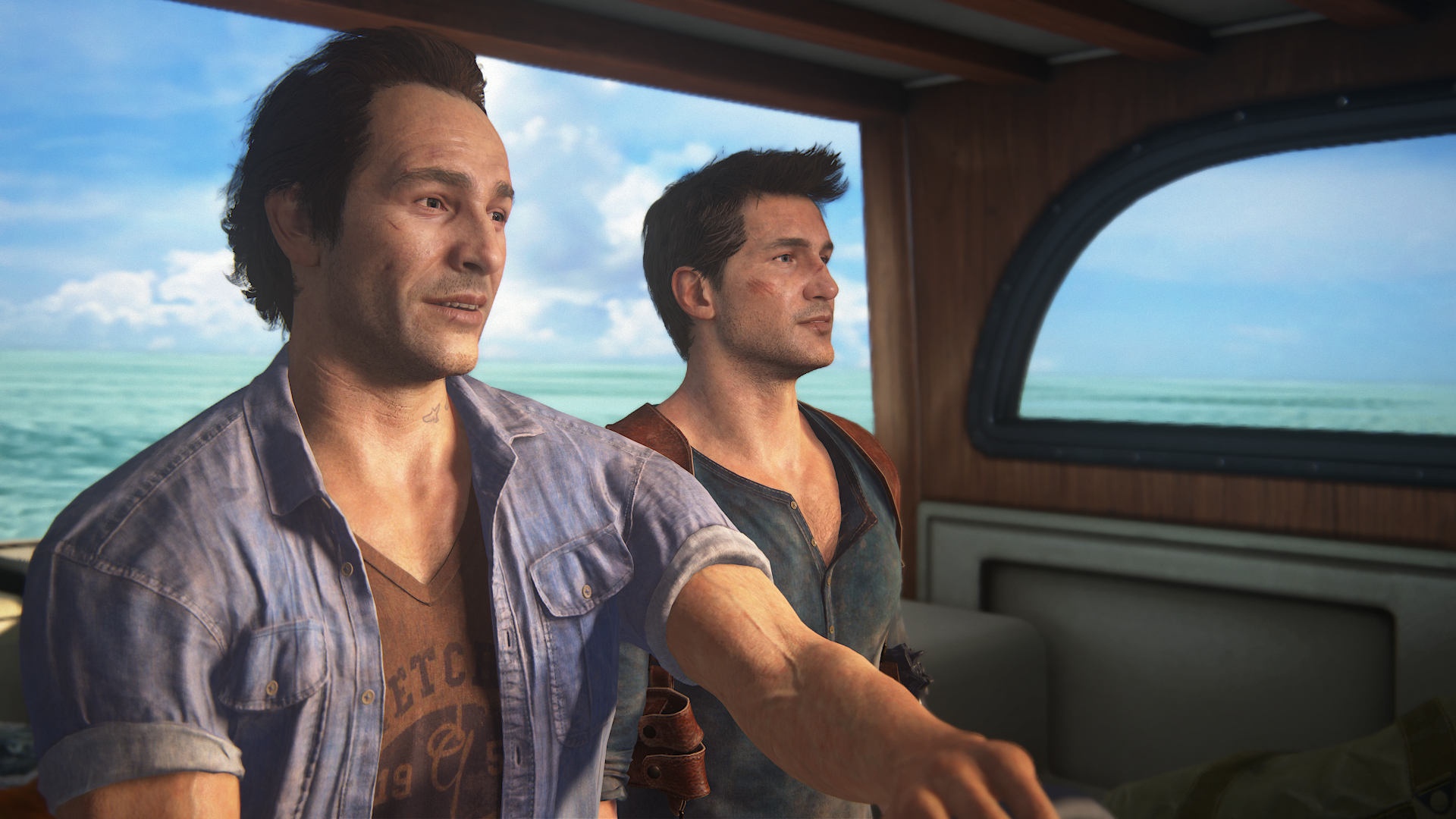Uncharted 4: A Thief’s End for PlayStation 4
I know it’s rude to stare for so long – to take in the glowing hillsides, watch foliage blowing dozens of yards in the distance, thousands of individual leaves weaving in and out of the sunlight – all while Nathan Drake waits patiently, hanging from a tower ledge by a quarter inch of his fingertips.
I slip once again on a grey, snowy cliffside. Below me patrol armed mercenaries, above me a few more, but here on this rocky outcropping, I notice specs of pollen floating in and out of view on the light breeze. I look beyond them, a ruined cathedral overtaking my sight. All the while, Nate silently passes time, sandwiched between two murderers. He doesn’t mind, I think. We both relish these moments, knowing they are among the last.
Uncharted 4: A Thief’s End is an epilogue in every moment, a knowledge shared by both player and character. Developer Naughty Dog has been steadfastly vocal about moving on from their acclaimed treasure hunting series, at the very least maintaining it will be the last story for our timeless hero, Nathan Drake.
We all await closure here, taking in our last feats as each chapter draws us nearer to the end of a nine-year journey. It’s not uncommon, I find, for characters to comment on the stunning views, or to lament their aching backs as we pull ourselves forward. They, as all players will, sense the finality of their adventure.
Several years after the events of Uncharted 3, Nate has settled into an almost uncomfortably pedestrian life, though he still finds himself flirting with his exhilarating past. It’s a relief, I realize, that he is as reluctant to let go as I am. Maybe this means the adventures never have to end.
This hope is answered upon the arrival of Samuel Drake, who needs his little brother and literal partner-in-crime to hunt down a long forgotten pirate treasure. His desperate call for help coaxes Nate away from his humble life, perhaps to less reluctance than Nate is willing to admit. You’ll explore the bonds both nurturing and dark between these two, Samuel’s arrival unearthing a past long buried and holding up a mirror to our hero’s destiny. Sam is an even more reckless version of Nate, and though a bit jarring random family additions can be, his arrival is a vital crux for Uncharted’s character arcs. He is addicted to the call of fortune, discovering its siren song alongside a brother who is learning to forget it. Two sides of a doubloon, these brothers; men of fortune carved from the same historic gold.
Age brought benefits along with its troubles, though. Being the fourth action-adventure of its brand, this is the pinnacle of Uncharted gameplay. Action seamlessly fuses with scripted cinematics time and again, leaving me wrestling my controller long before I realize it has no effect. Jumping and grabbing has been fine tuned well enough to prevent a lot of the old, random leaps in the wrong direction. Combat is cleaned up with the removal of some aged mechanics – no longer can you toss grenades back at foes or roll to collect ammo, two things I discovered by aimlessly stomping on live explosives and cartwheeling around the battlefield with an empty ammo cartridge.
Sluggish melee sequences are a thing of the past, as well. Most foes go down with a few jabs plus the occasional struggle, and fighting with a teammate will sometimes yield special duo-melee moves. Shooting even feels cleaner than ever, and the more accurate players will appreciate a subtle but satisfying headshot crosshair animation. Uncharted has never been much focused on gunplay, but this is the first title where it doesn’t feel antiquated against a backdrop of stunning content. The pieces have fallen so impeccably into place for the final scene. It is a bittersweet perfection.
Uncharted continues to be a masterclass in level design, for as always, Drake finds his route amidst what appears as a dauntingly open setting. Battlefields themselves have evolved, built with a focus on mobility and structural complexity. Most combat zones are layers of architecture spattered with tall grass, giving Nathan ample room to remain undetected between his acrobatics. This, coupled with his new ability to tag enemies in his sights, makes stealth a surprisingly viable option, and players who can maneuver out of view once caught will be able to throw off encounters completely.
Stealth’s noisier counterpart has its own joys, however. Nate now carries with him a roped grappling hook and an affinity for sliding down treacherous slopes. One at times will turn him into an armed human pendulum, the other can send him carelessly (for me, not him) barreling through enemy fire. Virtually no level goes without the crafty use of Nate’s new rope, an outwardly simple mechanic that adds a well-designed new dimension to exploration.
Housing these battlefields, Uncharted 4’s relentlessly gorgeous world plays a large part in the story’s grandeur. It seems to have expanded in every direction, with landscapes stretching for miles with incredible detail. It both benefits from and supplies the handful of new mechanics, for no better way to utilize a sprawling field than by wildly swinging and sliding through its strata. Our characters have grown just as impressive, the charming dialogue and flawless voice acting now matched by advanced facial animation. This cast is more lively than ever before. Perhaps as lively as they ever will be.
A striking newcomer to the series, dialogue options are only a handful in number, and function far more as easter eggs than anything else. Players will have their choice between which snarky Drake line to hurl at an adversary or which unbelievable discovery to share with his brother first. It’s a quirky customization Nate never needed, and its sparse implementation signals it as more of a playful nod to the series’ long history than an integral part of play. Similar are the various optional conversations in each level, usually triggered by approaching an ally at the right place and time. Both additions, though inconsequential, are peripheral bonuses lightly steeped in choice. Between the massive levels, new traversal techniques, and dialogue liberties, everything seems to reflect a sense of freedom, whether it be in a last hurrah or a snide contrast to its looming departure.
These moments of autonomy align with the title’s big themes, but more importantly, they become almost necessary in light of Uncharted’s past. At some point, in the water-soaked depths of a cave, Nathan briefly jests that he has become a “jaded treasure hunter.” One may fear the same for the player. Only so many times can we find splendor in discovering an ancient secret, so many times can our hearts stop when the beam we grabbed crumbles suddenly, or traverse incredible landscapes only to have them populated by an enemy racing towards the same goal. Novel bits and pieces do improve the experience, but in the grand scheme they give Uncharted the momentum to reach its conclusion.
As with most psychologies, most intriguing about these brothers is the object of their desire: a lifetime of loot amassed by the legendary Captain Henry Avery. Pirates, or Pyrates by the old pen, flew flags of freedom, refusing – or unable – to settle into the ways of average society. They traveled and plundered until the world moved on without them. Now extinct are history’s greatest treasure hunters, the Drakes’ largest inspirations. Adventurers can have no peace, no place.
“I am a man of fortune, and I must seek my fortune.” The ambiguous words of Captain Avery seem to echo through time for our heroes as they decide what is most valuable to them. Need a man of great destiny seek the treasures of his desire, might a man of great wealth seek out fame, should a man rich in gold seek immaterial wealth, or is he doomed to seek the former when he has found the latter?
Despite the orbs of conflict swirling around Nathan’s new exploits, from marital strain to this round’s psychopathic nemesis, this troublesome reflection lies center. He, like the player, is wrestling with memories of adrenaline. We are both coping, indulging, tossed between a thirst for adventure and an acceptance of the end.
The first three chapters of Drake’s tale sought greatness, a spirit not so relevant to A Thief’s End. Its clashing themes, self-referential script, accomplished cinematography and dynamic characters tell a profoundly human story of resolution. The feeling of boundless adventure burns brighter than that of a neatly closing door, but though this is not these characters’ highest caliber tale, this is the tale that rings true. Whether you find Uncharted 4’s conclusion satisfying is an endless calculation of spoilers and motives. As for myself, I’ll always long to see more of Uncharted, to hear the titular score over a new story, but if I do not, I will have witnessed an unforgettable end to a legacy.
Score: 5/5
Pros
| Cons
|






